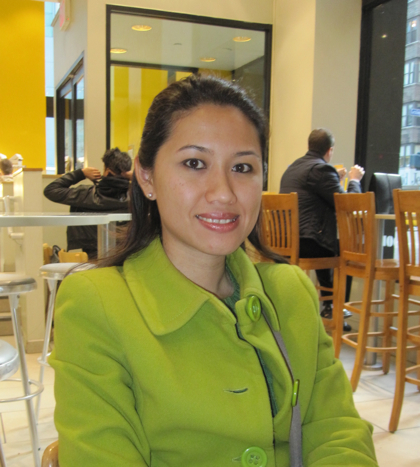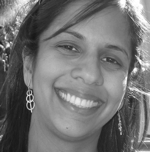From East Java to Tribeca
 Rinta Juwana moved to New York City from East Java, Indonesia, almost 12 years ago. Today, she works as an aesthetician at a Tribeca spa, but this tropical transplant hasn’t adopted all our ways yet. The day we met at a Midtown coffee shop, she was a welcome burst of color in the sea of black coats. We chatted about her impressions of the U.S., how it’s different from Indonesia, and why she thought she would be dodging bullets in New York City.
Rinta Juwana moved to New York City from East Java, Indonesia, almost 12 years ago. Today, she works as an aesthetician at a Tribeca spa, but this tropical transplant hasn’t adopted all our ways yet. The day we met at a Midtown coffee shop, she was a welcome burst of color in the sea of black coats. We chatted about her impressions of the U.S., how it’s different from Indonesia, and why she thought she would be dodging bullets in New York City.
How did you end up coming to New York?
I was 18 and had just finished high school. I didn’t know what I wanted to do, but a friend of mine in Indonesia had come to New York to attend beauty school and she convinced me to join her.
What did your parents think of that?
They weren’t happy, but they knew they couldn’t stop me. I was 18 and was so determined to come here that I applied for a passport without telling them. After I got it I told them my plans. My mother cried for weeks after I left.
Were there language barriers in the beginning?
Yes, I couldn’t understand anything anyone was saying because they spoke so quickly. Luckily, at beauty school there were lots of people from all over Asia and the teachers spoke to us in English—very slowly and patiently. In school, I learned English as a foreign language, the way you learn Spanish here, but I didn’t really learn it until after I moved here.
Apart from language, were there other struggles in the beginning?
Dressing for the winter. I arrived in August and knew I would need to buy a coat, but I didn’t know about scarves, gloves, sweaters, and other cold-weather clothes. I was always so cold. Finally, by the winter, my first salon manager called me aside one day and told me I needed to dress more warmly. She even gave me some of her gloves and scarves. It was also difficult to make friends. In Indonesia, people stop by your house unannounced. In New York, that’s unheard of. You have to make an appointment.
Did you know anyone here when you moved?
Just my high school friend who convinced me to come. She went to nursing school after beauty school, so she was really busy. But eventually I made friends at my church. There were lots of activities for people my age.
What are the main differences between New York and Indonesia?
In Indonesia, there are very rich people and very poor people, and not much in between. I don’t see a big gap like that here. The poverty is much worse in Indonesia and there are children begging on the streets. The government doesn’t take care of them there the way they would here. There’s no free health care either. If you go to a hospital here, they will treat you and not ask whether you can pay. In Indonesia, you have to pay first or they won’t even call you back to the examination room. Americans complain, but they don’t know how lucky they have it.
What turned out to the better than you expected about New York?
My whole image of the U.S. before I came here was from TV. American TV shows have so many guns and so I thought the U.S. would be really scary. I thought people would be shooting one another on the street.
Luckily, that’s not the case. What turned out to be worse than expected?
The winter. I remember my first snowstorm in 2000. I went out in the snow afterwards with my roommate and we loved it, at first. But it’s cold, and it’s not all about playing in the snow. Also, I wasn’t very independent when I got here. We had maids at home and I didn’t know how to do laundry or cook. The first time I made rice, I had to call my mother in Indonesia to find out how.
Was there anything that surprised you about New York?
I was stunned at how many people get manicures and pedicures in the U.S. Everyone you see on the subway has had their nails done. In Indonesia. it’s a big luxury, more like something you do for your wedding.
What do you think about Tribeca? Do you like working here?
I like it better than other neighborhoods in Manhattan that I’ve worked in. I have a better relationship with the customers and I think it’s because it’s such a small community and everyone knows one another. Their children go to school together and they are all very nice.
Any interesting New York stories?
I was in a Malaysian restaurant once and bumped into an old friend I knew from 7th grade in Indonesia. It was so strange to walk into a restaurant in New York and see a friend from Indonesia. Especially one I had lost touch with.
Where do you go in New York to get a taste of home?
My church, Woodside Church in Queens, does a food bazaar every summer that sells traditional Indonesian food. That’s very good. But as far as restaurants, I tried a Manhattan Indonesian restaurant once—I won’t say which one—and the food wasn’t very good.
How will your daughter’s childhood in New York be different from yours?
My parents were a bit old-fashioned and didn’t see much need for activities like piano or ballet. I want to give my daughter those opportunities here. Also, in Indonesia, everyone you meet is either native Indonesian or Chinese Indonesian, and there’s still a separation between the two groups. In New York, you meet people from all different countries. I want my daughter to make friends with everyone, and respect people of all races.
 About the author: Anojja Shah (left) is a Tribeca mom who spends her days running after a feisty 2-year-old. In past lives she worked as a journalist and on Wall Street in equity research. This Q&A is her second in a series of interviews with immigrants who live and/or work in Tribeca.
About the author: Anojja Shah (left) is a Tribeca mom who spends her days running after a feisty 2-year-old. In past lives she worked as a journalist and on Wall Street in equity research. This Q&A is her second in a series of interviews with immigrants who live and/or work in Tribeca.
Previous “I → NY” interviews:
••• From Montreal to Tribeca: Sarah Mlynowski












